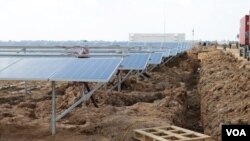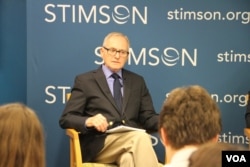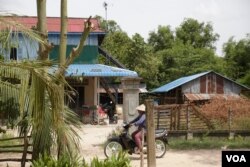Mekong Region countries like Cambodia should reconsider their plans to expand hydropower dams and coal plants, as the costs of alternative energy sources, such as solar power, are rapidly falling, a U.S. think-tank said, while improved regional grid connections can also ease growing energy demand.
Experts of the Washington-based Stimson Center provided these recommendations following the launch of a report in July that analyzed the economic and technological opportunities for improving and diversifying the Mekong Region’s energy mix.
Brian Eyler, who co-authored the report, said the region’s governments would be wise to review their energy master plans in order to not miss out on opportunities offered by new technologies, which carry less environmental and social impacts than large hydropower dams and coal-fired plants.
“It’s a good time to take a pause. Our message is not for countries in the Mekong Subregion to stop power-sector planning, but… to take a look at these emerging trends,” he said.
Courtney Weatherby, another author of the report titled “Mekong Power Shift: Emerging Trends in the GMS Power Sector,” said changing current energy master plans to include more wind and solar power, and cross-border energy trade, makes economic sense.
“There are a lot of changes that will have to happen in the power-utility sector that may be disruptive in the short term, but in the long term they will lead to much more flexible and resilient system,” she said.
Dams vs solar costs
Hundreds of large dams have been built or planned on the Mekong and its tributaries, as well as other rivers, in the Greater Mekong Subregion, which comprises Cambodia, Laos, Thailand, Vietnam, Myanmar, and south China’s Yunnan and Guangxi provinces.
Hydropower projects - many of which are planned with funding from Chinese, Thai, or other regional and Western investors - are often controversial due to their heavy environmental and social impacts. These disproportionately affect local villagers, while some dams - especially on the mainstream Mekong - can impact fish stocks across the region.
A total of 11 Mekong dams have been planned: nine are located in Laos – two of which are under construction and a third is approved – while two dams are proposed in Cambodia. Environmental group International Rivers has warned for years that the dams threaten the livelihoods of millions of poor fish-dependent villagers.
Campaigners, local activists, and downstream countries such as Vietnam have tried in vain to stop the dams. Coal-fired plants, meanwhile, are often opposed as they cause serious local air pollution, while they release carbon, which worsens climate change.
The Stimson Center researchers said alternative solar and wind technologies are quickly becoming more affordable and efficient, while these can also offer energy solutions in rural areas without grid connections.
They note, for example, that the U.S. average cost per unit for these respective energy sources dropped 85 percent and 65 percent between 2009 and 2016 — a trend that is likely to continue.
Weatherby said, “If you have solar available in the next few years at 6 cents a kilowatt hour, then some of the most-damaging dams really don’t make sense when you look at the economic calculus for building them” as many planned Mekong Region dams would sell power at 8 or 9 cent per unit.
Grid expansion
Experts said that as the Mekong countries expand their electricity sources and national grids through new technology and investment, there are also opportunities to improve efficiency in transmission, increase cross-border energy trade, and expand connections in rural areas.
“Through new power grid transmission, regional power trade and transmission mechanisms, the region can do more with a less-damaging power infrastructure,” said Eyler.
Particularly, Cambodia, Laos, and Myanmar, which have yet to develop large national grids, should expand through new grid management technology that can integrate renewable energy sources, while also investing in storage technology that can buffer intermittent supply from wind and solar energy.
Financing for energy supply innovation and grid expansion could come from the Asian Development Bank or China’s new Asian Infrastructure Investment Bank, the researchers suggested.
Cambodia looks to dams
Sao Sopheap, spokesperson of Cambodia’s Ministry of Environment, said hydropower remained nonetheless attractive, while claiming that the government has the capacity to carry out comprehensive environmental impact assessments for dams and address their negative impacts.
“We still need [energy]. We can generate energy from many sources and hydropower from the dams, we think, is a renewable energy that Cambodia has good potential for,” he said.
“The Ministry of Environment will do the environment impacts assessment… We check, evaluate and verify before agreeing that the study and evaluation is acceptable, and we (ensure) the environmental impacts can be reduced at maximum.”
According to official figures, about half of the country’s energy needs are currently met by hydropower, while almost a fifth is still imported from neighboring countries.
The Ministry of Mines and Energy could not be reached for comment.
On Monday, Prime Minister Hun Sen inaugurated the 400-megawatt Lower Sesan II Dam, located on a Mekong tributary in northeastern Cambodia’s Stung Treng Province. The country’s largest dam was developed by Cambodian conglomerate Royal Group and a subsidiary of the state-owned China Huaneng Group Corporation.
At the event, Hun Sen played down concerns over the $800-million dam’s impact on fisheries, adding that the effects of the nearby, 260-megawatt Don Sahong Dam - being built by Laos on a channel of the Mekong in an area where the rivers splits – had been negligible.
NGOs and local villagers have resisted the Lower Sesan 2 for years, but ultimately some 5,000 families were evicted from the area, while some 100 families held out for better compensation. Almost 40,000 upstream villagers are likely to see fish stocks collapse as fish migration routes become blocked, researchers have warned, while stocks could also suffer downstream.
Transparency and risk
The Stimson Center researchers said decisions on energy projects are not motivated by economic reasoning alone and they urged greater transparency in decision-making about, and allocation of, project tenders.
“Key changes would be to have competitive bidding for projects, which opens up opportunity for more outside analysis of what happens with individual projects,” said Weatherby.
The Mekong Region countries are plagued by high-level corruption and allegations of kickbacks for government officials awarding project contracts are not uncommon.
Richard Cronin, a Stimson Center fellow who was not involved in the report, said investment in large projects such as mega-dams also carry political and economic risks as projects can run aground. The China-backed Myitsone Dam in Myanmar, for example, was suspended by the government in 2011 following a public backlash against Chinese investment, which is deeply unpopular in the country.
“The Chinese still have like $1.2 billion in investment tied up in that project. It’s not going anywhere right now,” he said.
A recent push by the new National League for Democracy government to build more coal-fired plants and lower the energy share of hydropower dams is meanwhile running into local opposition at project sites in southern Myanmar.
Cambodia’s first solar farm
Despite the Cambodian government’s focus on hydropower dams, alternative energy project are advancing with donor support. On September 6, the country’s first solar farm, with a capacity of 10 Megawatt, came online in the eastern Svay Rieng Province. The $9.2 million project was developed by the Singapore-based Sunseap Group and funded through an Asian Development Bank loan.
During the opening ceremony, Keo Rottanak, director-general of state-run Electricite du Cambodge, lauded the clean energy it would provide and said a similar project could be developed near the capital Phnom Penh.
Independent experts and activists said developing such projects and creating a sizable wind and solar energy sectors in Cambodia would offer social and environmental benefits. But they warned that increasing supply and making the sectors price competitive with hydropower requires much more research, planning and investment.
“The challenge for this energy is the price… (currently) it requires users to buy energy at higher price. So production is the challenge,” said Tek Vannara, executive director of the NGO Forum on Cambodia.
Seak Sophat, the head of the Department of Natural Resource Management and Development at the Royal University of Phnom Penh, said for now hydropower has the upper hand and remains a good option “if we can construct it at a place where it has no impacts on natural resources and environment.”
Household solar panels
Meanwhile, rural Cambodian households are also becoming aware of the increasingly affordable solar-power technology. Household solar panels have become increasingly popular in recent years, with thousands of rural families installing the panels so that they can charge a battery to power simple home appliances.
Sun Sothea, 35, one of many market traders in Thnanh Village, Svay Rieng Province, said he bought a solar panel last year for about $400, which he said brings enough power to his home to use the lights and fans to cool off in the tropical heat.
“I cannot use it with big things, like running machinery or water pumps,” he said. “We still need (more) electricity soon.”
Another villager, In Boy, 65, said, “Since I have been waiting for electricity for so long, I decided to buy solar power to use. It’s so boring when there’s no electricity… Other residents in other areas have it too.”














